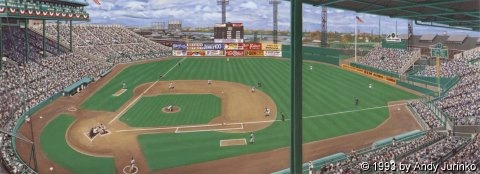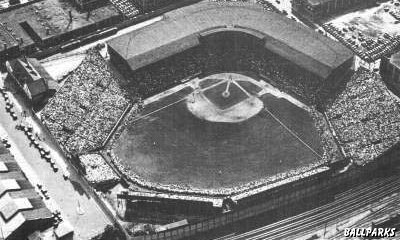Braves Field
Boston, MassachusettsTenant: Boston Braves Architect: Osborn Engineering Atlanta Braves & Boston Red Sox tickets:
Location: About three miles west of downtown Boston and one mile west of Fenway Park. First base (S), Akimbo Road, then Commonwealth Avenue; right field (E), Harry Agganis Way (formerly Gaffney Street); left field (N), Boston and Albany Railroad tracks, then Massachusetts Turnpike (I-90), then Charles River; third base (W), Babcock Street.
Dimensions: Left field: 402 (1915), 375 (1921), 404 (1922), 403 (1926), 320 (April 21, 1928), 353.5 (July 24, 1928), 340 (1930), 353.67 (1931), 359 (1933), 353.67 (1934), 368 (1936), 350 (1940), 337 (1941), 334 (1942), 340 (1943), 337 (1944); left-center: 402.5 ft. (1915), 396 (1916), 402.42 (1921), 404 (1922), 402.5 (1926), 330 (April 21, 1928), 359 (July 24, 1928), 365 (1942), 355 ft. (1943); center field: 440 ft. (1915), 387 (April 21, 1928), 417 (July 24, 1928), 387.17 (1929), 394.5 (1930), 387.25 (1931), 417 (1933), 426 (1936), 407 (1937), 408 (1939), 385 (1940), 401 (1941), 375 (1942), 370 (1943), 390 (1944), 380 (1945), 370 (1946); center field at the flag pole: 520; deepest center field corner, just to the right of straightaway center: 550 (1915), 401 (1942), 390 (1943); right-center: 402 (1915), 362 (1942), 355 (1943); right field: 402 (1915), 375 (1916), 365 (1921), 364 (1928), 297.75 (1929), 297.92 (1931), 364 (1933), 297 (1936), 376 (1937), 378 (1938), 350 (1940), 340 (April 1943), 320 (July 1943), 340 (April 1944), 320 (May 1944), 340 (April 1946), 320 (May 1946), 318 (1947), 320 (1948), 319 (1948); backstop: 75 (1915), 60 (1936). Fences: Left field to center: 10 (concrete, 1945), 8 (wood, 1928), 20 (wood, 1946), 25 (wood, 1953); left field scoreboard: sides 64 (1948), middle arch 68 (1929); left field: 1 (gravestones, July 24, 1928), 30 (canvas, 1929); right-center exit gate: 8 (wire); right field: 10 (six screen above 4 wood).
Braves Field was the last and largest of the first wave of concrete-and-steel ballparks built between 1909 and 1915. Owner James Gaffney built a wide open ballpark conducive to inside-the-park home runs. A covered single-deck grandstand seating 18,000 wrapped around the diamond from well down each foul line. Two uncovered pavilions seating 10,000 apiece occupied the areas just past the grandstand up to the foul poles. The jury box, as it was called after a sportswriter noticed during a game that only 12 spectators were sitting in the section, seated 2,000 and was located in right field. With the advent of the lively ball, baseball became a game of over-the-fence home runs for which Braves Field was ill equipped. So, in 1928 the fences were moved in and subsequently tweaked for years thereafter. After the Braves left in 1953, Boston University purchased the property, converted it for football and changed its name to Nickerson Field, where the B.U. Terriers played football until 1997. Field hockey and soccer games as well as commencement ceremonies are still held there. The old right-field pavilion has been incorporated into Nickerson's seating arrangement. The left field pavilion was replaced by an arena and the grandstand was replaced by three high-rise dormitory buildings. The first base ticket office and the concrete outer wall in right and center field are still standing.
Braves Field Trivia:
Recommended Reading (bibliography):
Help us provide a better web site by completing our feedback form PHOTOGRAPHS: Braves Field Panorama © 1993 by Andy Jurinko. Updated June 2006 Tickets to Atlanta Braves, Red Sox spring training, Boston Red Sox, NCAA Basketball Tournament, College Football Bowl, NCAA Football and Paul McCartney provided by Ticket Triangle. BALLPARKS © 1996-2014 by Munsey & Suppes.
|










